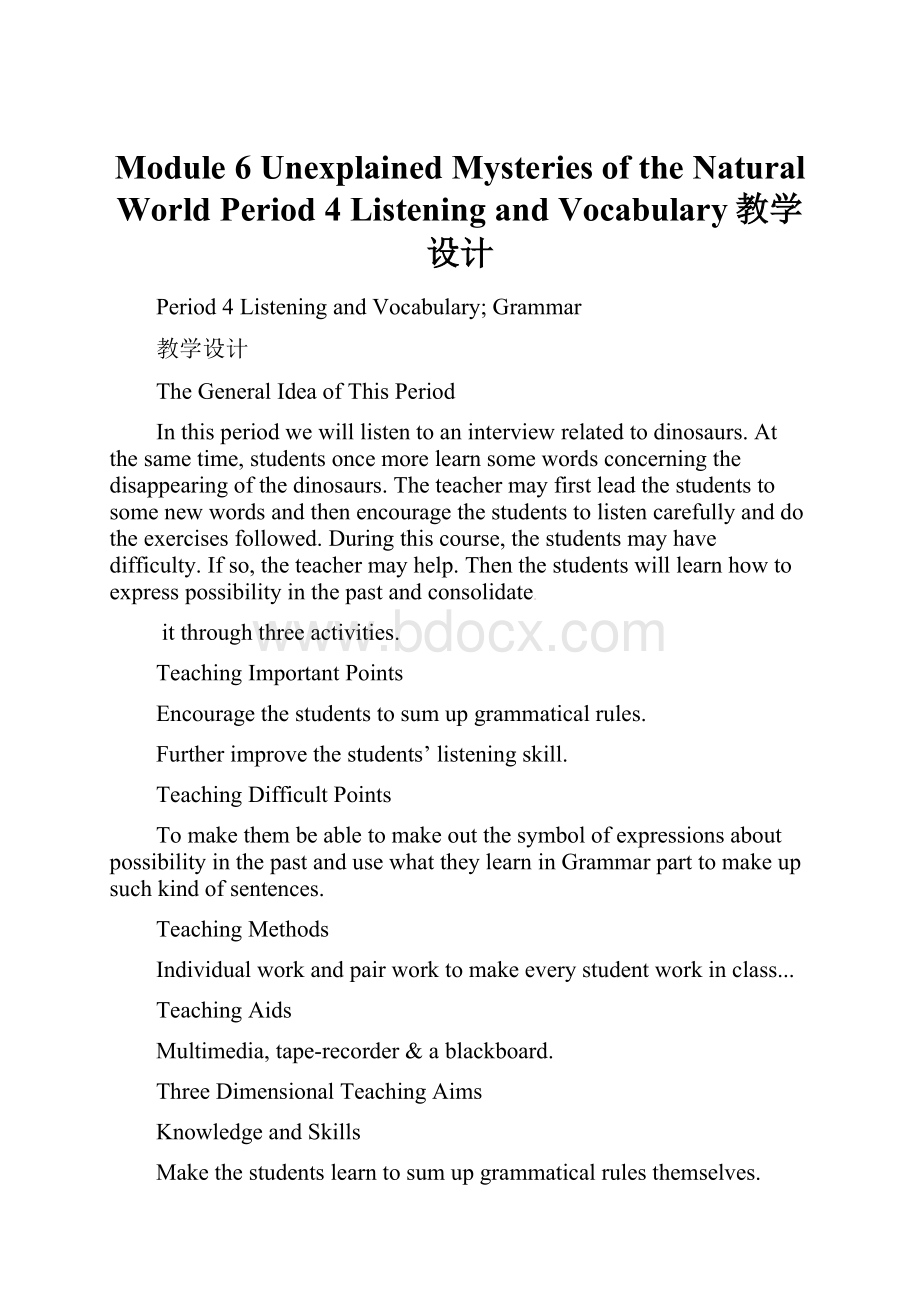Module 6 Unexplained Mysteries of the Natural World Period 4 Listening and Vocabulary教学设计.docx
《Module 6 Unexplained Mysteries of the Natural World Period 4 Listening and Vocabulary教学设计.docx》由会员分享,可在线阅读,更多相关《Module 6 Unexplained Mysteries of the Natural World Period 4 Listening and Vocabulary教学设计.docx(13页珍藏版)》请在冰豆网上搜索。

Module6UnexplainedMysteriesoftheNaturalWorldPeriod4ListeningandVocabulary教学设计
Period4ListeningandVocabulary;Grammar
教学设计
TheGeneralIdeaofThisPeriod
Inthisperiodwewilllistentoaninterviewrelatedtodinosaurs.Atthesametime,studentsoncemorelearnsomewordsconcerningthedisappearingofthedinosaurs.Theteachermayfirstleadthestudentstosomenewwordsandthenencouragethestudentstolistencarefullyanddotheexercisesfollowed.Duringthiscourse,thestudentsmayhavedifficulty.Ifso,theteachermayhelp.Thenthestudentswilllearnhowtoexpresspossibilityinthepastandconsolidate
itthroughthreeactivities.
TeachingImportantPoints
Encouragethestudentstosumupgrammaticalrules.
Furtherimprovethestudents’listeningskill.
TeachingDifficultPoints
TomakethembeabletomakeoutthesymbolofexpressionsaboutpossibilityinthepastandusewhattheylearninGrammarparttomakeupsuchkindofsentences.
TeachingMethods
Individualworkandpairworktomakeeverystudentworkinclass...
TeachingAids
Multimedia,tape-recorder&ablackboard.
ThreeDimensionalTeachingAims
KnowledgeandSkills
Makethestudentslearntosumupgrammaticalrulesthemselves.
Makesurethestudentsmasterthegrammaticalitems.
Trainthestudents’listeningabilityandimprovetheirlisteningskill.
TeachingandStrategies
Motivatethestudents’enthusiasmintakingpartintheclass.
FeelingsandValue
Throughthestudyofthisperiodthestudentswillsurelyknowmoreabouthowtoexpresspossibility,especiallyinthepastandunderstandtheimportanceofknowingaboutotheranimals’fortuneandtheirevolutionbylistening.
TeachingProcedures
Step1Revisionandlead-in
(Greetthestudentsasusual.)
Theteacherchecksthestudents’homeworkyesterday—searchingformoreinformationaboutmonsters,especiallydinosaurs.
(Theteacherasksafewstudentstodothis.)
Step2Listeningandvocabulary
T:
Inlastmodulewehavelearnedsomethingaboutperforminganinterviewaswellashowtoexpresspossibilityandimprobability.Nowfollowmetodosomelistening.InActivity1,youneedtocompletethesentenceswiththewordsinthebox.Lookatthescreenandfollowmetoreadthesewords,meanwhile,trytocatchtheirmeanings.
(Theteachershowsthefollowingwordsonthescreen.)
adapt climate disappear extinct evolve survive
T:
OK.Youhaveknownhowtoreadthesewordsandgotalltheirmeanings,right?
Students:
Yeah.
T:
Nowworkinpairsandcompletethesesentenceswiththewordsabove.
(Theteachershowsthesentencesonthescreen.)
1.The__________ofacountryisthetypeofweatherithas.
2.Ifananimalorplantis__________,itexistedalongtimeagobutdoesn’texistnow.
3.Whenthings__________,theynolongerhappenorexist.
4.Whenpeopleoranimals__________,theydon’tdieafteranaccidentoranillness.
5.Ifyoucan__________tosomething,youcanchangeinordertomakethesituationbetter.
6.Whenanimalsorplants__________,theychangeanddevelopoveralongperiodoftime.
(Theteachergoesaroundtheclasstohelpthosewhohavedifficultyindoingthis.Afewminuteslatertheteachercheckstheanswers.)
T:
Areyoureadynow?
Students:
Yeah.
T:
Good.Lookatthescreenandcheckifyouranswersarecorrect.Ifnot,correctthem,OK?
T:
Stophere.Haveyoufinishedyourcheckingyet?
Students:
Yes.
T:
Great.Nowworkinpairs.OnereadsthesentenceandtheothertranslatesitintoEnglish.
T:
Readynow?
Students:
Yes.
T:
Good.Youarerequiredtogooverthesewordsafterclass,areyouclear?
Students:
OK.
T:
Throughthefirstactivitywelearnsomenewwordsthatwillappearinthelisteningmaterial.Wearegoingtolearnsomethingaboutdinosaurs.Youmayhearofthem.Nowworkingroupsoffourtodiscussthefollowingquestions:
(Theteachershowsthethreequestionsandgivesthestudentstimetoprepare.)
1.Howmuchdoyouknowaboutdinosaurs?
2.Haveyoueverseenanyfilmsorreadanybooksaboutdinosaurs?
Whatinterestsyoumost?
3.Inyouropinion,whydinosaursdisappearedfromtheearth?
Giveyoureasons.
T:
Stophere.Justnowyoudiscussedheatedlyandmusthavegotsomethingaboutthishugeanimal.Accordingtowhatyoudiscussed,choosethebestanswerstothefollowingfoursentences.Ifyouhaveproblemsunderstandingthem,youcanholdupyourhandandturntomeforhelp,clear?
(Theteacherdisplaysthefollowingquestionsonthescreen.)
1.Dinosaursruledtheearthforabout__________millionyears.
A.twoB.twentyC.twohundred
2.Theyare__________.
A.plantsB.meatC.bothplantsandmeat
3.Theybecameextinct__________yearsago.
A.600000B.6millionC.66million
4.Theirnearestrelativestodayare__________.
A.birdsB.fishC.mammals
T:
(Alittlewhilelater)Haveyoufoundoutthecorrectanswers?
Students:
Wehavenoideaexactly.
T:
Well.Ifyouwanttogetthecorrectanswers,listentothefirstpartofaradiointerviewcarefully.Nowjust
listen
andtrytocatchthemainidea.
(Theteacherplaysthetapeforthestudents.)
T:
Haveyoucaughtthemainideayet?
Students:
Yes.Itmainlyintroducessomeinformationaboutdinosaurs.
T:
Youareclever.Listenagainandchecktheanswerstothequestionsabove.Andmeanwhilepayattentiontothepronunciationandintonation.
Students:
OK.
(Theteacherplaysthetapeagain.)
T:
Thesecondtimeisover.Let’schecktheanswerstogether.
Suggestedanswers:
1.C 2.C 3.C 4.A
T:
Congratulations!
You’vegotallofthem.Thatistosay,yourlisteningskillhasbeenimprovedgreatly.Let’scometothesecondpartoftheinterview.Beforewebegintolisten
tothispart,firstlookatthepicturesonP56ofyourbooksandtrytocatchthewords’meaning,whichmayhelpyoufurtherunderstandtheinterview.If
youcan,tickwhat
youhearintheinterview.
T:
AreyouOK?
Students:
Yes.
T:
Wonderful.Firsttimejustlistenandcatchthemainidea,clear?
Students:
(Studentsfollowtheteacher’sadvice.)
T:
Well,haveyougotthemainidea?
Students:
It’smainlyaboutthedisappearanceofthedinosaurs.
T:
Perfect.Nowlistenoncemoreandtrytohavea
goodunderstandingofthedetails.Thenyouneedtoexplainwhythedinosaursdisappearedandshowhowmanyexplanationsaregiven.
(Theteacherplaysthetapeonceagain.)
T:
Doyouknowwhythedinosaursdisappearedclearly?
Students:
Moreorless.
T:
Howmanyexplanationsaregivenforthedisappearanceofthedinosaurs?
(Differentstudentsgivedifferentanswers.)
T:
Youhavecaughtsomeofthereasons.Let’scheckthemonebyone.
Suggestedanswers:
1.Ameteoritehittheearth.
2.Theystoppedevolving.
3.Theykilledeachother.
4.Avolcaniceruption.
5.Cancercausedbyradiation.
T:
Justnowweexplainedwhydinosaursdisappeared.Inordertodeepenyourunderstanding,let’sdoanotherexercise.Lookthroughthestatementsonthescreenquicklyandmakeeffortstocatchtheirmeanings.
(Theteachershowsthestatementsonthescreen.)
1.Ahugemeteoritemayhavehitallthedinosaurs.
2.Perhapsadustcloudmadetheworlddark.
3.Ameteoritecausedavolcaniceruption.
4.Thedinosaurshadtoeatseedsandnutstosurvive.
5.Perhapstoomuchfightingcausedthedinosaurstodieout.
6.Onescientistbelievesthedinosaursbecameillwhentheyatethewrongfood.
7.Theremaybedinosaurstodaylivinginothergalaxies.
8.Dr.BinfieldthinksthecraternearMexicowascausedbyameteorite.
(Doastheteachertoldstudentsto.)
T:
ListenathirdtimeandjudgewhethertheyareTrueorFalse.
(Theteacherplaysthetapeathirdtime.)
Suggestedanswers:
1.F 2.T 3.F 4.F 5.T 6.F 7.F 8.T
Step3Grammar
T:
Okay,somuchforthecheck-up.Throughthelisteningactivitywegettoknowsomeexplanationsaboutthedisappearanceofdinosaurs.IsDr.Binfieldsurewhatcausedthedisappearanceofdinosaursontheearth?
Students:
No,heisn’t.
T:
Dr.Binfieldsays,”Thedinosaursmayhavestoppedevolving.”Whenhesaysthis,ishesurethatthedinosaursstoppedevolving?
Students:
No,heisn’t.
T:
Whenhesays,”Theymighthavekilledeachother.”Ishesureaboutthat?
Whatdoesthesentencemean?
Students:
No,heisn’t.Thatishisguessbutheisnotreallysureaboutthat.
T:
AccordingtothequestionsIjustasked,whydoweusemayhavedoneormighthavedone?
Students:
Weusethemtoexpresssomethingwhichhappenedinthepast—perhaps.
T:
Inordertopracticewhatwehavejustlearned,completethefollowingsentencesusingmayhave/mighthaveandthecorrectformoftheverbsinbrackets.Ifyouhavedifficulty,youcandiscussthemwithyourpartner.
(Theteachershowsthesentencesonthescreen.)
1.Themeteorite__________(cause)ahugedustcloud.
2.Thedustcloud__________(cutoff)thesunlight.
3.Smallanimals__________(survive)byeatingnutsandseeds.
4.Thedinosaurs__________(kill)byvolcaniceruptions.
(Theteachergoesaroundtheclassandhelpsthosewhoneedhelp.)
T:
(Afewminuteslater)Areyoureadynow?
Students:
Yes.
T:
Good.Let’scheckthemonebyone.Youmustsayitincompletesentences.Thefirstsentence,whatshouldwefillin?
Students:
Themeteoritemighthavecausedahugedustcloud.
T:
Completelytrue.Whataboutthesecondone?
Students:
Thedustcloudmayhavecutoffthesunlight.
T:
Perfect.No.3?
What’syouranswer?
Students:
Smallanimalsmayhavesurvivedbyeatingnutsandseeds.
T:
Wonderful.Howaboutthelastone?
Students:
Thedinosaursmighthavebeenkilledbyvolcaniceruptions.
T:
Absolutelyright.Nowworkinpairs.OnereadsthesentencesandtheothertranslatesthemintoChinese.Taketurnstodothis.Areyouclear?
Students:
(Follo